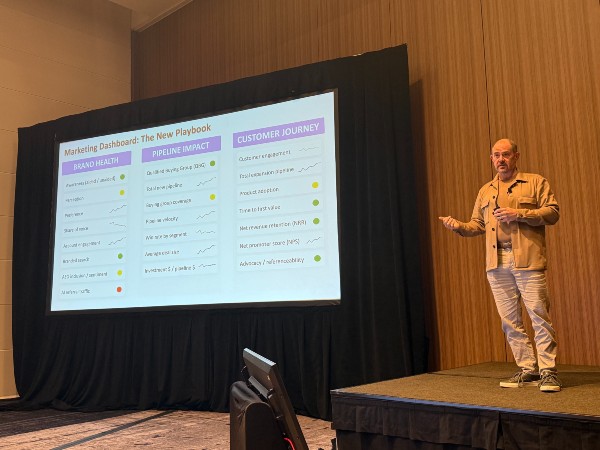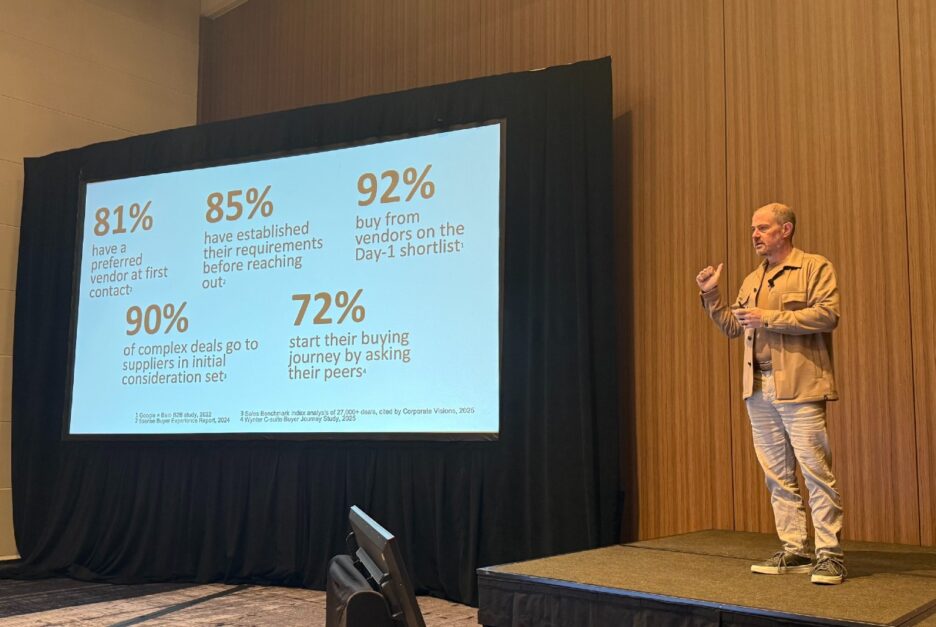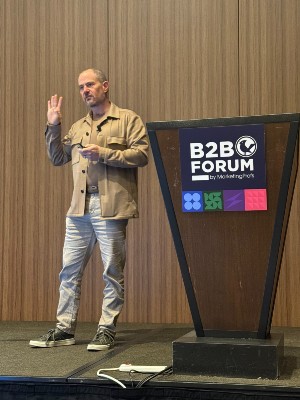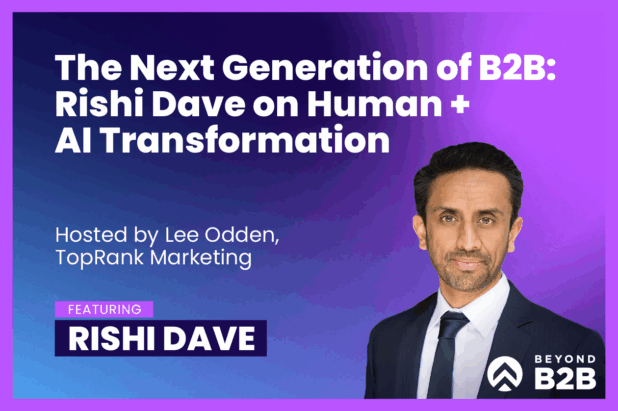Known for shaping and influencing the last two decades of B2B go-to-market-from co-founding Marketo to his roles as founder and CEO at Engagio and CMO at Demandbase, Jon Miller returned to the MarketingProfs B2B Forum stage this week with a message that resonates with what a lot of B2B marketers are feeling right now: the playbook that earned marketing a seat at the revenue table just isn’t working anymore.
He made that point with a mix of smart insights and his signature dad-joke humor, but the message underneath was serious: the combination of AI, shifts in buyer behavior, and systemic short-termism is breaking the age of the MQL. Buyers now move in non-linear ways, operate anonymously longer, and expect relevance long before they make contact.
As Jon put it in our podcast conversation,
“The old playbook just isn’t working anymore… it’s falling apart because buying is complex, nonlinear, and increasingly impossible to map in a simple cause-and-effect system.”
The Four Problems Breaking the Old Model of B2B Marketing
Jon talked about four structural issues that explain why B2B marketing best practices that worked for years are no longer cutting it:
1. Marketing is not a gumball machine.
For too long, teams defended budget by implying linearity, as in, feed the machine, get leads out. But attribution tied to isolated actions simply doesn’t reflect how buying groups behave today or how decisions are made.
2. The tragedy of the commons.
Today when a new B2B marketing tactic comes on the scene, everyone rushes in and popularize/exploit it. But buyers adapt, and the tactic loses its effectiveness. With AI making content low cost and infinite, this cycle accelerates. Jon joked about personalization making every prospect feel “specifically irrelevant”.
3. A chronic underinvestment in brand.
This was pretty much the heart of Jon’s argument about the broken B2B marketing playbook. By the time sales reaches out, 81% of buyers already have a preferred vendor in mind. Jon emphasized brand’s role in shaping early emotional preference-echoing what he told me in our interview: “Brand actually IS revenue marketing… it determines who buyers contact first.”
Meaningful, unique, defensible positioning (“MUD”) is no longer optional. Jon says it’s the only way to influence the invisible majority of buyers who never appear in your CRM.
4. Short-termism.
Pipeline pressure has turned marketers into “hamsters on a quarterly wheel.” Gating everything, over-interpreting form fills, and over-rotating on new business have collectively damaged the buyer experience and stunted long-term growth. In our Beyond B2B podcast interview, Jon actually mentioned how tools themselves baked in this bias: “There are deep structural reasons why SaaS has over-rotated to net-new business at the expense of customer lifecycle.”
What Works in the Age of AI
The emerging playbook Jon described aligns tightly with the reality we see every day at TopRank Marketing: buyers are invisible longer, AI intermediates more of the journey, and content abundance increases the importance of sources. Increasingly, sources of information are just as, or more important than the content itself.
Jon stressed three pillars of differentiation we need to pay attention to in the age of AI and I have to say, the alignment with our own Best Answer Marketing framework is incredible.
1. Trust and Relationships
In a world of infinite content, buyers gravitate toward credible sources-people and brands whose perspectives they trust. This includes communities, analysts, creators, employees, and executives. See BAM Trust Engine.
2. Experiences
AI can summarize information, but it can’t replicate human experiences-events, peer roundtables, workshops, dinners, and live interactions. These break through precisely because they cannot be reduced to a text snippet in an AI answer box. See BAM Experiential Content.
3. Craftsmanship
Audiences can feel the difference between something crafted with care and something mass-generated. Original research and proprietary data were two examples Jon highlighted repeatedly. He even mentioned this in our podcast interview, “AI cannot generate truly original research. It turns all the noise into meaning-and that gets cited, shared, remembered.” See BAM Data Informed.
It’s pretty easy to see how this aligns tightly with Best Answer Marketing’s emphasis on trust signals, experiential content, and multi-channel visibility, which are exactly the types of attributes AI-driven search systems reward.
AI’s Role: Continuous, Personalized Experiences
Jon’s vision for AI in B2B marketing is not “AI producing more content.” It’s AI enabling continuous, adaptive experiences at the person and buying-group level.
Jon says legacy Marking Auotmation Platforms (MAPs) Marketo, HubSpot, and Eloqua were built for a different era. They’re rule-based, email-centric, lead-centric systems that struggle with things like buying groups, behavioral signals, and cross-channel orchestration. The future is AI-native which features:
- Adaptive journeys rather than linear campaigns
- Playlists of next-best actions rather than rigid workflows
- Account-level signals from intent, job changes, social behaviors
- Buying group completeness and engagement as core metrics
- Orchestration across channels, not just email sequences
Again, the alignment with how our Best Answer Marketing system is evolving, especially in measurement and GEO/AEO optimization is amazing.
Reinventing B2B Marketing Measurement: From MQLs to Qualified Buying Groups
Jon’s challenge to the MQL offers up a replacement: the Qualified Buying Group (QBG).
Instead of counting leads, QBGs track:
- Buying group completeness
- Buying group engagement
- Buying group progression
- Pipeline velocity
- Win rate by segment
- Brand health and category perception
This “new QBG dashboard” aligns well with what we’re building in full-funnel analytics: unified data, brand measurement, buying group progression, and AI-search visibility. It also reflects how CFO conversations need to change: away from cost-per-lead and toward risk mitigation, improved win rates, and accelerated deal cycles.

The New B2B Marketing Playbook: Brand. Buying Groups. AI Orchestration. Long-Term Growth.
Jon wrapped things up with a old vs. new playbook comparison:
Old playbook:
- MQLs
- Attribution
- Gated content
- Short-termism
New playbook:
- Brand
- Buying groups
- AI-native orchestration
- Long-term value
It’s a shift toward meaning over mechanics which is exactly the direction the industry needs to move in as AI changes discovery, reduces website dependency, and compresses competitive differentiation. And it reinforces that I’ve been saying for years: B2B marketers can no longer win by simply informing buyers. They must make them feel something meaningful, early, and consistently.
Jon’s session was one of those rare presentations that both highlights a system-level problem and articulates a well thought out path forward. I think it’s easy to see that B2B marketing is at an inflection point. At the same time, the opportunities are significant for B2B brands willing to evolve by:
- Investing in brand as a revenue engine
- Prioritizing experiences, relationships, and craft
- Building trust signals that AI systems-and buyers-reward
- Shifting from leads to buying groups
- Embracing AI-native orchestration
- Measuring full-funnel impact, not just early-stage activity
As someone who’s known Jon for nearly two decades, it’s exciting to see him extending and reinventing the very categories he helped create. It’s also energizing to see how closely this new playbook reinforces the direction we’re taking with Best Answer Marketing in 2026.




